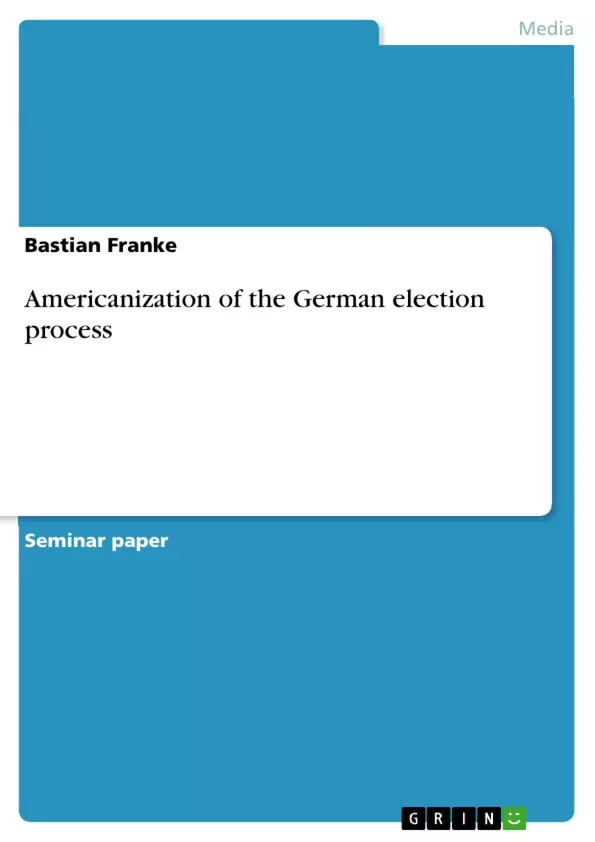„Zum Regieren brauche ich nur Bild, Bams und Glotze“ Bundeskanzler a.D. Gerhard Schröder
The elections to the German Bundestag in the last years seemed to have shown one thing clearly: the election campaigns are increasingly changing. Personalization and professionalization are just two of the keywords who dominate the campaigns not at least since the “Media Chancellor” Gerhard Schröder won the election in 1998. Like no chancellor before him, he relied on his impact of the media and his own popularity, which was always well ahead compared to his party. With the introduction of the first TV duels between the two top-candidates in German history of television in 2002, many observers came to the conclusion that there is a transformation of “national elections” to “chancellor elections”. The reasons for many analysts seem to be obvious. One of the much-discussed is the spill-over of Americanization from German society to the politics. But what means the Americanization of German election campaigns and which characteristics can be found? Or have these developments rather to be seen as a modernization-process that has occurred at first in the United States?
The goal of the following work is to discuss and debate these questions, and subsequently to analyze the level of Americanization on the basis of the developments in television-debates ahead the German Bundestag elections.
To reach this, the paper starts with an overview of Americanization as a cultural transfer process followed by a discussion of the characteristics of Americanization in the political communication. Thereafter the question of modernization or Americanization is reviewed. The second chapter examines the history of television debates in the USA and Germany followed by an analysis. Finally, the concluding remarks will complete the work.
Inhaltsverzeichnis (Table of Contents)
- Introduction
- Americanization as a cultural transfer process
- Characteristics of Americanization in the political communication
- The Americanization thesis
- Personalization
- Professionalization of the campaign organization
- Election campaign strategies - negative campaigning
- Americanization or modernization?...
- Interim conclusion
- The history of television debates.
- Television debates in the USA
- Television debates in Germany
- Americanization of television debates in Germany
- Concluding remarks.
Zielsetzung und Themenschwerpunkte (Objectives and Key Themes)
This work explores the phenomenon of Americanization within German election campaigns, specifically examining its influence on television debates. The paper aims to define Americanization in the context of political communication and analyze its characteristics, including personalization and professionalization of campaigns. It further investigates the role of television debates in shaping the German electoral landscape and whether their development reflects Americanization or a broader modernization process.
- Americanization of German election campaigns
- Influence of Americanization on political communication
- Role of television debates in German elections
- Comparison of Americanization and modernization in political campaigns
- Analysis of television debates as a reflection of Americanization
Zusammenfassung der Kapitel (Chapter Summaries)
- Introduction: This chapter introduces the topic of Americanization in German election campaigns, highlighting the increasing personalization and professionalization of campaigns, particularly since the 1998 election. It outlines the goal of the work to analyze the level of Americanization through the lens of television debates.
- Americanization as a cultural transfer process: This chapter provides an overview of Americanization as a cultural transfer process, exploring its dynamics and impact on various aspects of society.
- Characteristics of Americanization in the political communication: This chapter delves into the specific characteristics of Americanization in the political communication sphere. It examines the Americanization thesis, personalization, professionalization of campaign organization, negative campaigning, and the ongoing debate surrounding Americanization versus modernization.
- The history of television debates.: This chapter provides a historical overview of television debates in both the USA and Germany, tracing their evolution and impact on electoral politics.
Schlüsselwörter (Keywords)
Americanization, German election campaigns, political communication, television debates, personalization, professionalization, negative campaigning, modernization, cultural transfer process, electoral landscape.
- Quote paper
- Bastian Franke (Author), 2010, Americanization of the German election process, Munich, GRIN Verlag, https://www.grin.com/document/168635



